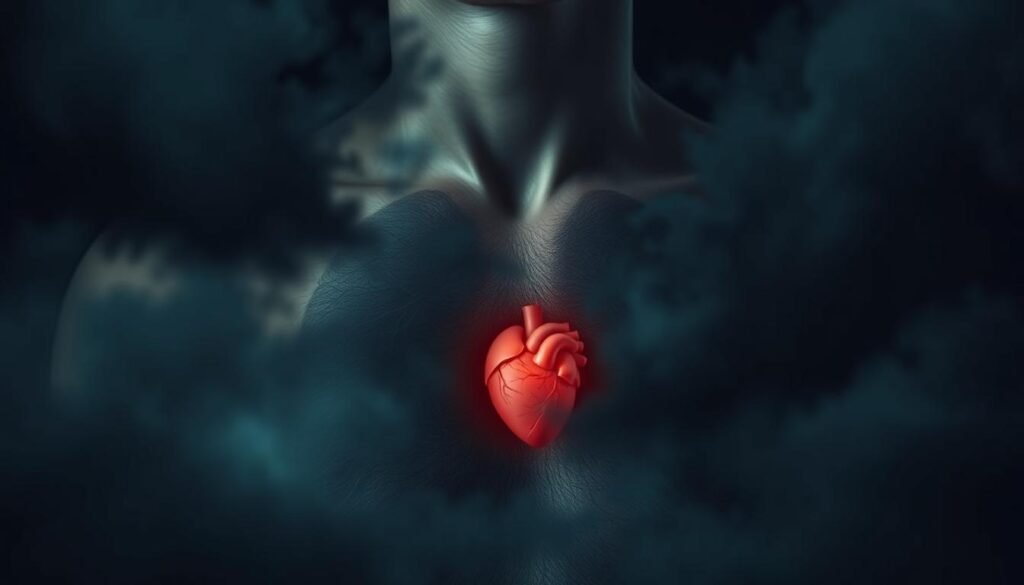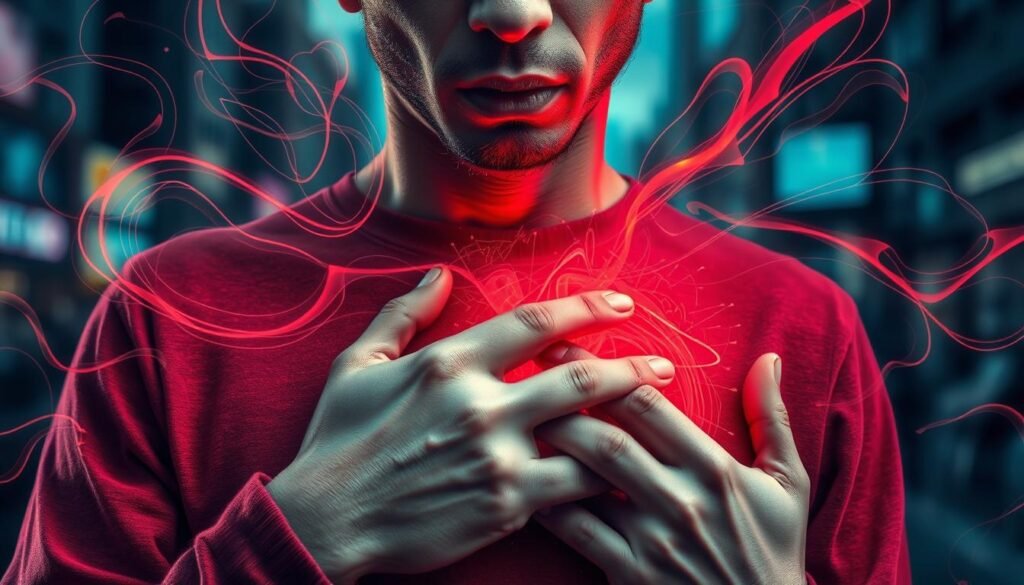Did you know that nearly 12% of people in the United States have anxiety disorders at some point? These disorders can cause many troubling symptoms. The most common is shortness of breath, or dyspnea. This condition makes daily life harder and brings on panic attacks. People struggle with the fear of not breathing enough. Knowing how anxiety leads to these physical symptoms can help people handle their stress better. It also encourages them to get the right help.
Anxiety can trigger scary physical signs. This article helps readers figure out their symptoms and know when to get medical help. Telling the difference between breathing problems from anxiety and from serious health issues can reduce needless worry. It can also improve health. For tips on dealing with anxiety-related breathing trouble, check this helpful resource.
Key Takeaways
- Anxiety disorders affect about 12% of the U.S. population.
- Common symptoms of anxiety include shortness of breath, known as dyspnea.
- Shortness of breath can be mistaken for conditions like heart disease or lung diseases.
- Anxiety can manifest physical signs such as rapid breathing and muscle tension.
- Prompt assistance is essential for managing both anxiety and respiratory issues.
- Effective breathing techniques can alleviate anxiety-related shortness of breath.
- Professional treatment options, including therapy, can help manage anxiety symptoms.
Understanding Anxiety and Its Physical Effects
Anxiety is a common feeling of worry, fear, and unease about what’s to come. It can turn into serious anxiety disorders, affecting daily life. One main physical effect of anxiety is having trouble breathing. This shows how closely anxiety and breathing problems are linked. Knowing these signs helps in managing them well.
When you’re anxious, your body reacts in many ways. You might breathe faster, feel chest tightness, or feel like you have a lump in your throat. Other signs are stiff muscles, a racing heart, dizziness, nausea, and being unable to sit still. Doing breathing exercises can ease breathlessness during anxiety attacks. It’s good to do this for 5 to 10 minutes every day.
To deal with anxiety breathlessness, try grounding exercises, distractions, positive self-talk, or quick self-care like cold water on your face. Keeping a log of your thoughts helps in spotting triggers and feelings. Meditating regularly and practicing mindfulness helps too. Getting advice from a therapist can teach you useful ways to cope.
When dealing with anxiety disorders, it’s crucial to check out different treatments. These include therapies like cognitive behavioral therapy (CBT) and acceptance and commitment therapy (ACT), and medicines like antidepressants and benzodiazepines. By understanding the physical effects of anxiety, you can look for the right help and avoid the mistake of wrong diagnosis, since its signs can look like other health issues.
Anxiety disorders can start when you’re young and stay into adulthood. They have many forms like panic attacks, social phobia, and more. Things like trauma, stress from illness, certain personalities, and family history can increase the risk. Symptoms often include a fast heartbeat, sweating, trouble sleeping, and breathing fast.
| Symptom | Physical Response |
|---|---|
| Increased Heart Rate | Fight-or-flight response activation |
| Chest Tightness | Increased muscle tension and respiration |
| Shortness of Breath | Difficulty in breathing patterns |
| Dizziness | Altered blood flow and anxiety spikes |
| Nausea | Gastrointestinal disturbance |
The Physiology of Shortness of Breath
Feeling short of breath is closely linked to our body’s inner workings, especially with anxiety. It’s tied to how we breathe. Anxiety sets off the body’s fight-or-flight mode. This makes our brain send out stress signals, changing how fast our heart beats and our breathing pattern.
When we’re anxious, we breathe faster. This is our body gearing up for what it thinks is danger. But, this can make us feel like we’re not getting enough air. It adds to our stress and anxiety, making it a complex issue.
Studies show how our minds affect how we breathe. People with anxiety might breathe differently or struggle more with breathing tasks. How hard breathing feels can depend a lot on our mood. Understanding this can help us handle anxiety and its effect on breathing better.
Physical Symptoms of Anxiety-Induced Shortness of Breath
It’s important to know the Physical Symptoms of Anxiety-Induced Shortness of Breath. This type of shortness of breath often starts without warning. It makes it hard for people to breathe deeply. This can make them feel like they’re not getting enough air. This feeling can make their anxiety worse. It creates a cycle that makes the discomfort grow.
Common Signs to Recognize
To manage anxiety better, it helps to know its physical signs. Here are some key signs:
- Accelerated heart rate
- Increased sweating
- Trembling or shaking
- Chest pain or tightness
- Dizziness or feeling faint
These symptoms, along with anxious shallow breathing, cause what’s known as anxiety-triggered dyspnea. Doing breathing exercises and practices for relaxing can help people during these moments.
Link to Other Anxiety Symptoms
Anxiety shows itself in many physical forms. It often goes hand in hand with headaches, feeling sick, and tense muscles. Sometimes, it’s hard to tell these symptoms apart. Studies have found that anxiety could increase the chance of getting diseases like asthma, heart disease, and migraines. That’s why it’s key to deal with these issues in a whole way. This includes therapy, joining support groups, and learning how to relax.
| Symptoms | Common Causes |
|---|---|
| Shortness of Breath | Anxiety, asthma, COPD |
| Increased Heart Rate | Panic attacks, stress |
| Trembling | Anxiety, low blood sugar |
| Chest Pain | Anxiety, heart issues |
| Dizziness | Anxiety, dehydration |
Panic Attack Breathing Issues
Panic attacks bring about significant panic attack breathing issues. They cause sudden and intense shortness of breath. This can feel overwhelming, leaving you dizzy and panicked.

During a panic attack, you might breathe too fast. This hyperventilation makes you feel lightheaded. Recognizing these panic disorder breathing problems helps manage anxiety. It’s helpful to learn specific breathing methods.
Diaphragmatic breathing or paced respiration are good techniques. They help counteract the effects of hyperventilating. These strategies are key in lessening panic attack symptoms.
Using effective coping strategies is crucial. Mindfulness practices bring calm. Seeking treatments like cognitive behavioral therapy (CBT) can help too. They tackle the anxiety’s root causes and offer practical help.
Consulting professional resources, like information on shortness of breath, is useful. It helps tell panic attack issues apart from other conditions. This ensures you get the right treatment.
Hyperventilation and Anxiety: A Closer Look
Hyperventilation often happens when someone is anxious, leading to fast breathing. This quick breathing lowers carbon dioxide in the blood. This can cause feelings of dizziness and light-headedness. Knowing about hyperventilation helps people see how anxiety changes their breathing.
Understanding Hyperventilation
Many people with panic disorder experience hyperventilation. It affects about 50% of them. Meanwhile, 25% of those with hyperventilation syndrome might develop panic disorder later. Symptoms like a quick heartbeat, chest pains, feeling light-headed, and having trouble breathing can be scary. They are often mistaken for heart problems. Learning to control breathing can help stabilize breathing.
How It Affects Breathing Patterns
Anxiety can make it hard to breathe steadily. Various things and health issues can start hyperventilation. Though some think breathing into a paper bag helps, it’s still debated. Using techniques to control breathing can provide quick help during these episodes.
If you hyperventilate for the first time or can’t control your breathing quickly, getting checked by a doctor is important. Repeated episodes might mean you have hyperventilation syndrome or need to address anxiety through therapy or meds. Knowing these signs is key to avoiding panic attacks caused by hyperventilation.
To better manage, understanding the link between hyperventilation and anxiety is crucial. It leads to better handling of the situation and a better life.
Anxiety Chest Tightness and Its Impact
Anxiety chest tightness is a common symptom among people feeling very anxious. It feels like a tight band around the chest. This may scare someone because it seems like a heart problem. It’s vital to know this is a way our body reacts to stress.
This tightness can happen for many reasons, making us feel more anxious. When we get anxious, our body reacts by making our hearts beat faster and our breathing quicken. Not everyone with anxiety feels it hard to breathe, but it’s a common issue.
To deal with this chest tightness, finding the right ways to cope is key. Medicines like benzodiazepines and SSRIs often help. Psychotherapy, especially CBT and psychodynamic therapy, provides great support. Using breathing exercises can also help control our breathing and reduce tightness.
It’s easy to confuse anxiety symptoms with other health problems. That’s why seeing a doctor if chest tightness happens often is important. They can help make sure we’re treated right.

| Symptom | Description |
|---|---|
| Anxiety Chest Tightness | A constricting sensation in the chest often accompanying anxiety. Can be mistaken for heart issues. |
| Increased Heart Rate | Elevated heart rates are typical during anxiety attacks, contributing to feelings of panic. |
| Shortness of Breath | A feeling of not getting enough air, common in various anxiety symptoms. |
| Mental State Impact | Chest tightness can exacerbate anxiety levels, creating a cycle of stress. |
| Physical Symptoms Link | Body’s stress response can lead to muscle tension, contributing to chest pain. |
Recognizing Anxious Rapid Breathing
Anxious rapid breathing is a key sign of severe anxiety. It happens when a rush of emotions triggers body reactions. These symptoms can cause breathing patterns to change, making panic worse. Spotting this kind of breathing early helps in controlling its impact.
When anxious, your body prepares to either fight or flee. This causes your heart to beat faster and your breaths to become quick and shallow. Feelings like dizziness, sweating, or fear of bad things happening may also appear. Watching these signs lets people find ways to calm themselves.
Sometimes, not dealing with anxious breathing can make anxiety and breathing problems feed off each other. Experts might suggest breathing exercises to help. For example, breathing through the diaphragm or taking breaths through pursed lips can slow breathing down. This helps fight off anxiety symptoms.
It’s key to understand how anxiety affects the body. Not all will struggle with breathing. But knowing when breathing changes because of anxiety is important. It helps tell it apart from other health issues. Recognizing the difference is vital for getting the right medical care quickly.
There are many treatments for these symptoms. Techniques like cognitive behavioral therapy (CBT) and being mindful help people handle stress better. In severe instances, doctors might prescribe medicine for quick relief. Using these treatments together can greatly improve how someone copes with anxious rapid breathing.
| Treatment Approaches | Description | Effectiveness |
|---|---|---|
| Cognitive Behavioral Therapy (CBT) | A form of therapy that helps individuals change negative thought patterns. | High |
| Mindfulness Practices | Techniques focused on being present and reducing stress. | High |
| Benzodiazepines | Medications for short-term relief of severe anxiety symptoms. | Medium to High |
| Diaphragmatic Breathing | A breathing technique to enhance relaxation and reduce anxiety. | High |
| Pursed Lip Breathing | A method to control breathing by slowing it down. | Medium to High |
Distinguishing Anxiety-Triggered Dyspnea from Other Conditions
Understanding anxiety-triggered dyspnea is crucial. Shortness of breath often means anxiety. But, it can also point to serious health issues. These include asthma, chronic obstructive pulmonary disease (COPD), or heart conditions. It’s important to tell anxiety symptoms from these issues. This requires looking closely at other signs and why the breathlessness happens.
When you’re anxious, you might have a fast heartbeat, tense muscles, or feel shaky. Dizziness is common too. If you’re also having chest pain or fainting, it could be something serious. Then, it’s best to get medical help right away. People who are overweight might feel short of breath when anxious, especially if they’re active.
If breathing hard is a constant issue, get professional advice. A detailed check-up can show if it’s health-related or just anxiety. The right assessment leads to the best treatment. This could be medical treatment or psychological help, like therapy or relaxation practices.
Looking into resources such as the Grouport Therapy blog can give more insight. Below is a comparison of anxiety-triggered dyspnea and related conditions:
| Condition | Symptoms | Management |
|---|---|---|
| Anxiety-Triggered Dyspnea | Shortness of breath, rapid heart rate, dizziness, feelings of panic | Relaxation techniques, cognitive-behavioral therapy |
| Asthma | Wheezing, chest tightness, coughing, shortness of breath | Inhalers, medications, avoiding triggers |
| COPD | Chronic cough, sputum production, wheezing, difficulty breathing | Medications, pulmonary rehab, oxygen therapy |
| Heart Conditions | Chest pain, shortness of breath during exertion, fatigue | Medical interventions, lifestyle changes |

Effective Strategies to Manage Anxiety Respiratory Distress
Many people face anxiety respiratory distress, dealing with symptoms like fast breathing and higher heart rates. Knowing how to cope can really help you control these symptoms. Diaphragmatic and pursed lip breathing are key for keeping your breathing steady and easing distress.
Diaphragmatic breathing lets you take deep breaths from your diaphragm, improving oxygen flow and calming you down. It’s great for easing anxiety and can also lower your blood pressure, boosting overall health. Besides, techniques like slow deep breaths, counting while breathing, and meditative breathing can help you focus and cut down on anxiety.
Using mindfulness and staying active enhance your lung health and battle stress. These strategies give you the power to handle anxiety respiratory distress, making you feel more in control. If you’re really struggling with anxiety or panic attacks, it’s key to talk to a doctor for a full treatment plan.
Adding breathing exercises to your daily life, along with therapy and maybe medication, can really make a difference in handling anxiety. Sticking to these practices, like doing them six times a week, builds your ability to cope with anxiety over time.
Conclusion
Understanding anxiety symptoms is key, especially when it comes to shortness of breath. In the U.S., around 40 million people face anxiety disorders. They show signs like muscle tension, dizziness, and breathlessness.
These signs are crucial to note for quick help and to avoid worse health problems. Recognizing these symptoms is the first step to manage them effectively.
Anxiety brings physical changes that can be tough to handle. But there are ways to deal with them. Manual breathing exercises and psychotherapy help those with anxiety’s breathlessness. For more tips, check out this informative resource.
Learning more about anxiety and spreading awareness is important. It helps people find the right treatment. When individuals understand their symptoms and seek support, they improve their well-being. This leads to a healthier, more balanced life.